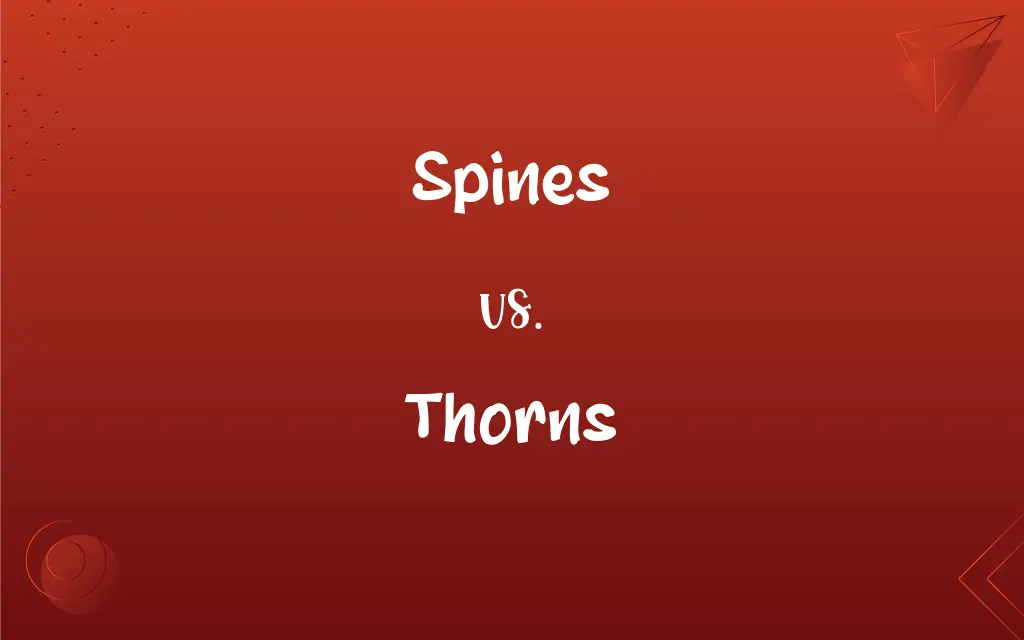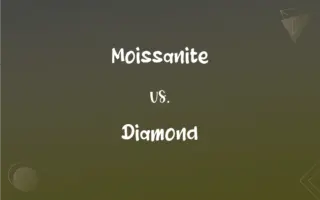Spines vs. Thorns: What's the Difference?
Edited by Janet White || By Harlon Moss || Updated on June 25, 2024
Spines are modified leaves protecting plants and deterring herbivores; thorns are sharp, woody, modified stems serving similar purposes.

Key Differences
Spines and thorns, though often used interchangeably, hold botanical distinctions that differentiate them. Spines derive from modified leaves, stipules, or parts of leaves. In contrast, thorns are derivatives of shoots, contributing to differing structural and functional aspects within plant biology.
Spines are a plant’s defensive adaptation, strategically evolved to reduce water loss and discourage herbivory. Often, plants in arid regions deploy spines as a measure to conserve moisture by replacing leaves, thereby minimizing surface area and reducing transpiration. Thorns, while also having defensive utility, typically stem directly from the plant’s woody part, serving not just as protectors but also as supportive structures in some instances.
Thorns, being modified stems, often display more rigid, woody characteristics and are typically located along the plant’s branches and stems. Although their primary function is also to deter herbivores and protect the plant from being eaten, their woody nature implies that they remain year-round in many species, contrasting with the potentially seasonal nature of spines, which can be shed alongside leaves in certain species.
Moreover, spines, being derivatives of leaves or parts of leaves, can have varied forms and may also engage in photosynthesis, which isn’t a prominent feature in thorns. The involvement of spines in metabolic activities like photosynthesis marks a significant physiological distinction between spines and thorns, even while their ecological roles might largely overlap.
Both spines and thorns have been instrumental in facilitating plant survival amidst herbivorous threats, albeit via different anatomical and physiological pathways. Their occurrences, whether as spines or thorns, are resultant from the plants’ adaptive strategies, sculpted by their specific environmental interactions and evolutionary pathways.
ADVERTISEMENT
Comparison Chart
Botanical Origin
Derived from leaves or parts of leaves
Derived from shoots or branches
Physiological Function
Can engage in photosynthesis
Do not engage in photosynthesis
Structural Appearance
May be smaller and occur where leaves are or were located
Typically woody and located on stems
Seasonality
May be shed in some species alongside leaves
Generally persistent throughout seasons
Involvement in Metabolism
Can potentially be involved in metabolic processes due to leaf origin
Less likely to be involved in metabolism
ADVERTISEMENT
Spines and Thorns Definitions
Spines
Spines may serve to minimize water loss in plants by reducing surface area.
The spines of desert-dwelling plants minimize water loss by limiting transpiration.
Thorns
Thorns generally remain with the plant throughout all seasons, offering persistent protection.
Hawthorn trees maintain their thorns throughout winter, providing consistent defense against herbivores.
Spines
Spines can potentially be seasonal, being shed and regrown in certain plant species.
Some plants shed their spines in particular seasons, similar to deciduous leaves.
Thorns
Thorns are modified stems or branches designed to protect plants from herbivores.
The rose's thorns effectively discourage animals from eating its leaves and flowers.
Spines
Spines are modified leaves or parts of leaves evolved predominantly for plant protection.
Cacti utilize spines, which evolved from leaves, to deter herbivores.
Thorns
Thorns can sometimes serve as climbing aids, enabling plants to reach sunlight in densely vegetated areas.
The thorns of some brambles assist the plant in climbing and anchoring onto nearby structures.
Spines
In some plants, spines are involved in metabolic processes like photosynthesis.
The spines of certain cacti can perform photosynthesis, contributing to the plant’s energy production.
Thorns
Thorns are typically hard, sharp structures that deter herbivory by causing physical discomfort.
Birds perched on acacia trees remain cautious of the sharp thorns beneath the foliage.
Spines
Spines can appear in various forms and sizes, dependent on their species and ecological function.
The spines on a rose bush, although commonly misidentified as thorns, serve to protect the plant from herbivores.
Thorns
Unlike spines, thorns do not participate in photosynthesis and are not involved in metabolic activities.
Despite being an integral part of the plant, thorns do not engage in the photosynthetic process.
Spines
The spinal column of a vertebrate.
Thorns
A modified branch in the form of a sharp woody structure.
Spines
(Zoology) Any of various pointed projections, processes, or appendages of animals.
Thorns
Any of various other sharp protuberances, such as a spine.
Thorns
Any of various shrubs, trees, or woody plants bearing such sharp structures.
Thorns
Any of various sharp protuberances on an animal.
Thorns
One that causes sharp pain, irritation, or discomfort
He is a thorn in my side.
Thorns
The runic letter þ, used in Old English, Middle English, and Old Norse manuscripts to represent both the voiceless sound (th) of Modern English thin and the voiced sound (th) of Modern English this, and in modern Icelandic orthography to represent the voiceless sound (th).
Thorns
Plural of thorn
FAQs
Can spines be involved in photosynthesis?
Yes, some spines, being modified leaves, can engage in photosynthesis.
Do thorns perform photosynthesis?
Typically, no, thorns do not perform photosynthesis as they are modified stems or branches.
What are spines in botanical terms?
Spines are plant structures derived from leaves or leaf parts, designed for protection and reducing water loss.
What is the primary function of spines?
Primarily, spines deter herbivores and can also reduce water loss in some plants.
Do all plants have thorns or spines?
No, the presence of thorns or spines depends on the species and its evolutionary history.
What is the difference between thorns, spines, and prickles?
Thorns are modified stems, spines are modified leaves, and prickles are surface outgrowths of the epidermis or cortex.
How can you identify thorns on a plant?
Thorns are usually woody, sharp structures emerging from branches or stems.
Why do plants develop thorns?
Thorns serve primarily as a defensive mechanism against herbivores.
Are spines and thorns the same?
No, they differ in botanical origin, structure, and sometimes, function.
Are spines present year-round on plants?
This can vary, as some plants may shed spines seasonally, while others retain them year-round.
Do spines have a role in plant health?
Yes, spines can influence plant health by offering protection and/or participating in photosynthesis.
Do thorns serve purposes other than protection?
Predominantly for protection, but in some plants, they may aid in climbing or structural support.
Are there plants with poisonous or irritating thorns?
Yes, some plants have thorns that can deliver toxins or irritants when touched or pricked.
Are all sharp plant structures considered thorns?
No, depending on their botanical origin, sharp structures might be thorns, spines, or prickles.
Can thorns be of different shapes and sizes?
Yes, thorns can vary in shape and size depending on the plant species.
Can a thorn develop into a branch or flower?
Generally, no, thorns do not develop into branches or flowers.
Is there a relationship between the environment and the development of spines?
Yes, environments with higher herbivory risk or water scarcity may foster spine development.
Can spines appear on plant fruits?
Yes, spines can be found on various plant parts, including fruits, like in the case of some cacti.
Can spines and thorns exist on the same plant?
Yes, some plants may possess both spines and thorns, each derived from different plant parts.
Can the development of spines impact a plant’s energy usage?
Yes, the development and maintenance of spines may have energy costs, influencing overall energy allocation.
About Author
Written by
Harlon MossHarlon is a seasoned quality moderator and accomplished content writer for Difference Wiki. An alumnus of the prestigious University of California, he earned his degree in Computer Science. Leveraging his academic background, Harlon brings a meticulous and informed perspective to his work, ensuring content accuracy and excellence.
Edited by
Janet WhiteJanet White has been an esteemed writer and blogger for Difference Wiki. Holding a Master's degree in Science and Medical Journalism from the prestigious Boston University, she has consistently demonstrated her expertise and passion for her field. When she's not immersed in her work, Janet relishes her time exercising, delving into a good book, and cherishing moments with friends and family.
































































